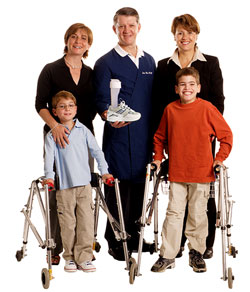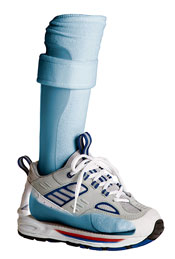 |
| Hilory Paster, VP Sales & Marketing; John Wall, PT, CPO, FAAOP; Lori Watson, Founder & President. Children: Samuel Paster, Hilory’s son and William Watson, Lori’s son. |
Driven by the challenge of finding
functional, durable, comfortable, and fashionable shoes for their
children to wear with AFOs, Lori Watson and Hilory Paster joined
together in late 2002 to create a shoe solution for children with
cerebral palsy and other conditions that require adaptive
shoes.
During a visit to my son’s orthotist, I became frustrated that
the new shoes I had purchased were the wrong size for his new
braces,” says Watson, founder and president of Keeping Pace Inc.,
Boston, Massachusetts. She continues, “In a somewhat off-handed
remark, I stated I was going to have molds made for William’s foot
which would allow for the required extra depth, a cut-line for leg
length discrepancy, a durable toe-cap and much more. The orthotist
encouraged me to meet a specialty footwear design team in Salem,
Massachusetts.” At that point she brought Paster, who became the
company’s vice president of sales and marketing, into the
conversation. The two knew each other from working together at an
early childhood therapy center for their children.
“One conversation led to another, and before long, a strategic
partnership was developed between SoleTech and Keeping Pace,” adds
Watson. SoleTech, a specialty footwear designer, manufactures the
shoes for Keeping Pace, and Keeping Pace handles, sales, marketing,
and distribution. SoleTech had received similar requests for shoes
before, but the company was impressed with the clear
interpretations and real-world understanding that the two women
brought to the table.

According to United Cerebral Palsy (UCP), an
estimated 800,000 people in the US are afflicted with cerebral
palsy. Ten thousand more babies are born each year with this
condition. An estimated 70 percent of these children require some
type of orthotic supportfoot/leg brace/ankle-foot orthoses or
adaptive shoes.
In most cases, AFOs are custom-fabricated and fit to the
specific individual’s needs as prescribed by medical personnel.
Orthotists and physical therapists often think outside the box and
explore available options that will help the child utilize most of
his or her capabilities. The practitioners strive to assist the
weak muscles, control abnormal muscle tone, improve alignment, and
increase stability. The ultimate goal is to enhance and improve the
child’s abilities to walk.
After AFOs Fitted, Search Begins
Once the prescribed AFOs have been made to the child’s
particular specifications, the daunting task of finding shoes
begins.
“Shopping for shoes has never been easy,” says Paster. “Since my
son has needed to wear AFOs, I have dreaded going into the stores
to find shoes. I would travel from store to store, maneuvering my
physically challenged child, looking for a pair of shoes that would
fit the braces. They needed to be deep enough, long enough, and
wide enough. To ease the process, I began to travel with the braces
in hand. In desperation, I must have bought more shoes than could
have possibly been worn, hoping to find that magical pair.
“In the end, I ended up buying shoes that were two sizes larger
than the shoe size that was actually needed. I would force the shoe
to work by taking out the inner sole, stretching the material, and
praying that they would last at least a month before I needed to
start the process all over again.”
But often normal wear and tear on these “adapted” shoes meant it
would only be weeks or a month before the child would wear holes in
the shoe.
Getting the Right Shoe
Watson and Paster explain that a properly designed shoe must
have a depth that will enable the hinges, posterior stops, and/or
Velcro® straps to sit well below the heel counter. The shoe
should securely support the brace and not break down or collapse
from its pressure. A shoe that has more than one insole does not
necessarily mean that it is deeper and will accommodate the AFO. It
is necessary to take a good look at how much depth is actually
gained upon removing the insole and what happens to the integrity
of the shoe once the insoles are removed.
Exposing the natural internal sole of the shoe will tell you a
great deal about the manufacturing quality of the product. Look for
a smooth surface that is free of glues, rough spots, or exposed
materials that can cause abrasions, breakdown, and discomfort.
Closely examine the shoe to see what role the insoles play in
creating a firm, supportive cavity. The support and strength of the
shoe should be provided by the quality of the materials and
construction, not by the use of the insoles.
Pay close attention to the materials used in manufacturing the
shoe. Unfortunately, the “typical” shoe manufacturer cannot address
the specifics of specialty shoe design; most off-the-shelf shoes
are not created for children with toe drag, scissoring, or
challenging gait patterns.
Watson and Paster also stress the importance of style. “Children
who need specialty shoes want to be as fashionable as their peers,”
comments Paster. “Just because a shoe fits an orthosis does not
mean it has to be unattractive or clunky. Our shoes offer
contemporary fashion and stylish looks as well as well-engineered
design.”
Finally, the company’s founders are focused on providing an
affordable product for families whose budgets are taxed with so
many other costs of caring for a child with special needs.

They are off to a great start. Keeping Pace
substantially increased its manufacturing production since it
started selling shoes in January 2005 and distributes in the US as
well as Europe, Australia, and Singapore.
“With proceeds from our sales, Keeping Pace will be donating
financial resources to fund research programs,” says Watson.
“Today, Keeping Pace is run by parents of children with special
needs. Supporting our team are orthotists, specialty footwear
designers, friends, and family. It is because of their skills and
encouragement that Keeping Pace thrives today.”
For more information, visit www.keepingpace.com




